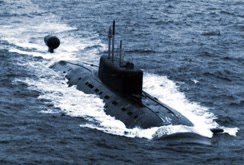The Sierra class, Soviet designations Project 945 Barrakuda and Project 945A Kondor, (NATO reporting names Sierra I and Sierra II respectively), are series of nuclear-powered attack submarines intended for the Soviet Navy and currently in service with the Russian Navy.
 The class is unique due to its light and strong titanium pressure hull which enables the submarines of the class to dive to greater depths, reduce the level of radiated noise and increase resistance to torpedo attacks. It is powered by a single OK-650 pressurized water reactor.
The class is unique due to its light and strong titanium pressure hull which enables the submarines of the class to dive to greater depths, reduce the level of radiated noise and increase resistance to torpedo attacks. It is powered by a single OK-650 pressurized water reactor.
The first submarine of the Project 945, Carp, was laid down in July 1979 at the Gorky shipyard and was launched in August 1983 before being transferred to Severodvinsk for fitting out. It was laid up in 1997. The next hull to be built was Kostroma, which was launched in July 1986 and was commissioned in September 1987. K-276 Kostroma was put into a drydock after its 11 February 1992 collision with the US submarine USS Baton Rouge in the Barents Sea, off Kildin Island. The submarine was repaired on 3 June 1992 and was renamed Krab on 6 April 1993, but in 1996 its original name, Kostroma was returned and it is in active service with the Russian Northern Fleet. The Sierra I class was also fitted with a releasable escape pod for the crew. The pod is covered by a V-shaped casing on the port side of the sail.
 The class is unique due to its light and strong titanium pressure hull which enables the submarines of the class to dive to greater depths, reduce the level of radiated noise and increase resistance to torpedo attacks. It is powered by a single OK-650 pressurized water reactor.
The class is unique due to its light and strong titanium pressure hull which enables the submarines of the class to dive to greater depths, reduce the level of radiated noise and increase resistance to torpedo attacks. It is powered by a single OK-650 pressurized water reactor.The upgraded version, the Sierra II class was specifically developed for search and destroy missions against US nuclear submarines. It has a smaller turning circle than any other modern submarine, with speeds and diving depth greater than its American counterparts. It has also improved quieting and sonar.
The Project 945A has a considerably larger sail which is 5 m (16.4 ft) longer than the Sierra I class. The sail also has a curious flat, square leading edge. The masts are offset on the starboard side to make way for two escape pods in the sail. The starboard side also has a 10-point environment sensor fitted at right angles to the front end of the sail. Also, the Sierra II class has a much larger pod on its after fin. The pod houses the Skat 3 passive very low frequency towed sonar array. More details